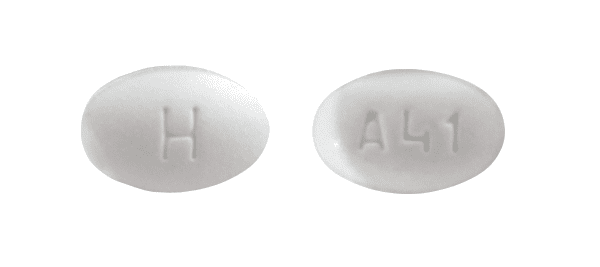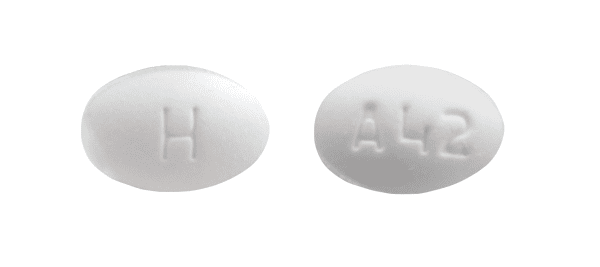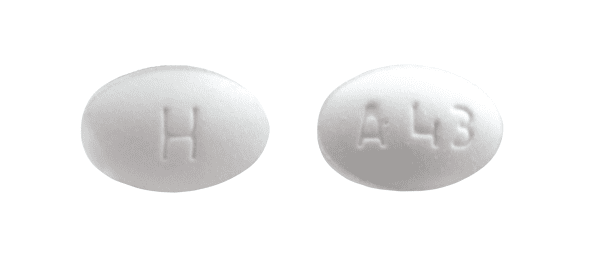Dosage Forms
Excipient information presented when available (limited, particularly for generics); consult specific product labeling.
Tablet, Oral:
Stendra: 50 mg, 100 mg, 200 mg
Pharmacology
Mechanism of Action
Does not directly cause penile erections, but affects the response to sexual stimulation. The physiologic mechanism of erection of the penis involves release of nitric oxide (NO) in the corpus cavernosum during sexual stimulation. NO then activates the enzyme guanylate cyclase, which results in increased levels of cyclic guanosine monophosphate (cGMP), producing smooth muscle relaxation and inflow of blood to the corpus cavernosum. Avanafil enhances the effect of NO by inhibiting phosphodiesterase type 5 (PDE-5), which is responsible for degradation of cGMP in the corpus cavernosum; when sexual stimulation causes local release of NO, inhibition of PDE-5 by avanafil causes increased levels of cGMP in the corpus cavernosum, resulting in smooth muscle relaxation and inflow of blood to the corpus cavernosum; at recommended doses, it has no effect in the absence of sexual stimulation.
Pharmacokinetics/Pharmacodynamics
Absorption
Rapid
Metabolism
Hepatic via CYP3A4 (major), CYP2C (minor); forms metabolites (active and inactive)
Excretion
Feces (~62%); urine (~21%)
Time to Peak
Plasma: 30 to 45 minutes (fasting); 1.12 to 1.25 hours (high-fat meal)
Half-Life Elimination
Terminal: ~5 hours
Protein Binding
~99%
Use in Specific Populations
Special Populations: Renal Function Impairment
In mild renal impairment, AUC0-inf decreased by 2.9%and Cmax increased by 2.8%; in moderate renal impairment, AUC0-inf increased by 9.1% and Cmax decreased by 2.8%.
Special Populations: Hepatic Function Impairment
In mild hepatic impairment, AUC0-inf increased by 3.8% and Cmax decreased by 2.7%; in moderate hepatic impairment, AUC0-inf increased by 11.2% and Cmax decreased by 51%.
Special Populations: Elderly
AUC0-inf increased by 6.8% and Cmax decreased by 2.1%.
Use: Labeled Indications
Erectile dysfunction: Treatment of erectile dysfunction
Contraindications
Hypersensitivity to avanafil or any component of the formulation; coadministration with any form of organic nitrates (either regularly and/or intermittently) or guanylate cyclase stimulators (eg, riociguat)
Dosage and Administration
Dosing: Adult
Erectile dysfunction: Oral: Initial: 100 mg taken ~15 minutes prior to sexual activity; taken as one single dose and not more than once daily; dose may be increased to 200 mg ~15 minutes prior to sexual activity or decreased to 50 mg ~30 minutes prior to sexual activity using the lowest dose that provides benefit; maximum 200 mg daily
Dosing adjustment with concomitant medications:
Alpha-blocker (dose should be stable at time of avanafil initiation): Initial avanafil dose: 50 mg taken as one single dose and not more than once daily.
Moderate CYP34A inhibitors (including amprenavir, aprepitant, diltiazem, erythromycin, fluconazole, fosamprenavir, verapamil): Maximum avanafil dose: 50 mg taken as one single dose and not more than once daily.
Strong CYP3A4 inhibitors (including atazanavir, clarithromycin, indinavir, itraconazole, ketoconazole, nefazodone, nelfinavir, saquinavir, ritonavir, telithromycin): Avoid concomitant use of avanafil.
Dosing: Geriatric
Elderly ≥65 years: Refer to adult dosing.
Administration
May be administered with or without food, ~15 to 30 minutes prior to sexual activity.
Storage
Store at 20°C to 25°C (68°F to 77°F); excursions are permitted to 30°C (86°F). Protect from light.
Avanafil Images
Drug Interactions
Alcohol (Ethyl): May enhance the hypotensive effect of Phosphodiesterase 5 Inhibitors. Monitor therapy
Alpha1-Blockers (Nonselective): Phosphodiesterase 5 Inhibitors may enhance the hypotensive effect of Alpha1-Blockers (Nonselective). Management: Ensure patient is stable on one agent prior to initiating the other, and always initiate combination using the lowest possible dose of the drug being added. When tadalafil is used for treatment of BPH, concurrent alpha 1-blockers are not recommended. Consider therapy modification
Alpha1-Blockers (Uroselective): May enhance the hypotensive effect of Phosphodiesterase 5 Inhibitors. Monitor therapy
Alprostadil: Phosphodiesterase 5 Inhibitors may enhance the adverse/toxic effect of Alprostadil. Avoid combination
Amyl Nitrite: Phosphodiesterase 5 Inhibitors may enhance the vasodilatory effect of Amyl Nitrite. Avoid combination
Blood Pressure Lowering Agents: Phosphodiesterase 5 Inhibitors may enhance the hypotensive effect of Blood Pressure Lowering Agents. Monitor therapy
Bosentan: May decrease the serum concentration of Phosphodiesterase 5 Inhibitors. Phosphodiesterase 5 Inhibitors may increase the serum concentration of Bosentan. Monitor therapy
Bosentan: May decrease the serum concentration of CYP3A4 Substrates (High risk with Inducers). Monitor therapy
Clofazimine: May increase the serum concentration of CYP3A4 Substrates (High risk with Inhibitors). Monitor therapy
Conivaptan: May increase the serum concentration of CYP3A4 Substrates (High risk with Inhibitors). Avoid combination
CYP3A4 Inducers (Moderate): May decrease the serum concentration of CYP3A4 Substrates (High risk with Inducers). Monitor therapy
CYP3A4 Inducers (Strong): May increase the metabolism of CYP3A4 Substrates (High risk with Inducers). Management: Consider an alternative for one of the interacting drugs. Some combinations may be specifically contraindicated. Consult appropriate manufacturer labeling. Consider therapy modification
CYP3A4 Inhibitors (Moderate): May increase the serum concentration of Avanafil. Management: The maximum avanafil adult dose is 50 mg per 24-hour period when used together with a moderate CYP3A4 inhibitor. Patients receiving such a combination should also be monitored more closely for evidence of adverse effects. Consider therapy modification
CYP3A4 Inhibitors (Strong): May increase the serum concentration of Avanafil. Avoid combination
Dabrafenib: May decrease the serum concentration of CYP3A4 Substrates (High risk with Inducers). Management: Seek alternatives to the CYP3A4 substrate when possible. If concomitant therapy cannot be avoided, monitor clinical effects of the substrate closely (particularly therapeutic effects). Consider therapy modification
Dapoxetine: May enhance the orthostatic hypotensive effect of Phosphodiesterase 5 Inhibitors. Avoid combination
Deferasirox: May decrease the serum concentration of CYP3A4 Substrates (High risk with Inducers). Monitor therapy
Enzalutamide: May decrease the serum concentration of CYP3A4 Substrates (High risk with Inducers). Management: Concurrent use of enzalutamide with CYP3A4 substrates that have a narrow therapeutic index should be avoided. Use of enzalutamide and any other CYP3A4 substrate should be performed with caution and close monitoring. Consider therapy modification
Erdafitinib: May decrease the serum concentration of CYP3A4 Substrates (High risk with Inducers). Monitor therapy
Erdafitinib: May increase the serum concentration of CYP3A4 Substrates (High risk with Inhibitors). Monitor therapy
Etravirine: May decrease the serum concentration of Phosphodiesterase 5 Inhibitors. Monitor therapy
Fluconazole: May increase the serum concentration of Avanafil. Management: Limit avanafil to a maximum dose of 50 mg per 24-hour period in any patient who is also receiving a moderate inhibitor of CYP3A4 such as fluconazole. Consider therapy modification
Fosaprepitant: May increase the serum concentration of CYP3A4 Substrates (High risk with Inhibitors). Monitor therapy
Fusidic Acid (Systemic): May increase the serum concentration of CYP3A4 Substrates (High risk with Inhibitors). Avoid combination
Idelalisib: May increase the serum concentration of CYP3A4 Substrates (High risk with Inhibitors). Avoid combination
Itraconazole: May increase the serum concentration of Avanafil. Avoid combination
Ivosidenib: May decrease the serum concentration of CYP3A4 Substrates (High risk with Inducers). Monitor therapy
Ketoconazole (Systemic): May increase the serum concentration of Avanafil. Avoid combination
Larotrectinib: May increase the serum concentration of CYP3A4 Substrates (High risk with Inhibitors). Monitor therapy
Lorcaserin: May enhance the adverse/toxic effect of Phosphodiesterase 5 Inhibitors. Specifically, the risk of developing priapism may be increased. Monitor therapy
Lorlatinib: May decrease the serum concentration of CYP3A4 Substrates (High risk with Inducers). Management: Avoid concurrent use of lorlatinib with any CYP3A4 substrates for which a minimal decrease in serum concentrations of the CYP3A4 substrate could lead to therapeutic failure and serious clinical consequences. Consider therapy modification
Mitotane: May decrease the serum concentration of CYP3A4 Substrates (High risk with Inducers). Management: Doses of CYP3A4 substrates may need to be adjusted substantially when used in patients being treated with mitotane. Consider therapy modification
Molsidomine: May enhance the hypotensive effect of Phosphodiesterase 5 Inhibitors. Avoid combination
Nitroprusside: Phosphodiesterase 5 Inhibitors may enhance the hypotensive effect of Nitroprusside. Avoid combination
Palbociclib: May increase the serum concentration of CYP3A4 Substrates (High risk with Inhibitors). Monitor therapy
Phosphodiesterase 5 Inhibitors: May enhance the adverse/toxic effect of other Phosphodiesterase 5 Inhibitors. Avoid combination
Posaconazole: May increase the serum concentration of Avanafil. Avoid combination
Riociguat: Phosphodiesterase 5 Inhibitors may enhance the hypotensive effect of Riociguat. Avoid combination
Sapropterin: May enhance the hypotensive effect of Phosphodiesterase 5 Inhibitors. Monitor therapy
Sarilumab: May decrease the serum concentration of CYP3A4 Substrates (High risk with Inducers). Monitor therapy
Siltuximab: May decrease the serum concentration of CYP3A4 Substrates (High risk with Inducers). Monitor therapy
Simeprevir: May increase the serum concentration of CYP3A4 Substrates (High risk with Inhibitors). Monitor therapy
Simeprevir: May increase the serum concentration of Phosphodiesterase 5 Inhibitors. Monitor therapy
Stiripentol: May increase the serum concentration of CYP3A4 Substrates (High risk with Inhibitors). Management: Use of stiripentol with CYP3A4 substrates that are considered to have a narrow therapeutic index should be avoided due to the increased risk for adverse effects and toxicity. Any CYP3A4 substrate used with stiripentol requires closer monitoring. Consider therapy modification
Tocilizumab: May decrease the serum concentration of CYP3A4 Substrates (High risk with Inducers). Monitor therapy
Vasodilators (Organic Nitrates): Phosphodiesterase 5 Inhibitors may enhance the vasodilatory effect of Vasodilators (Organic Nitrates). Avoid combination
Voriconazole: May increase the serum concentration of Avanafil. Avoid combination
Adverse Reactions
>10%: Central nervous system: Headache (1% to 12%)
2% to 10%:
Cardiovascular: Flushing (3% to 10%), ECG abnormality (1% to 3%)
Central nervous system: Dizziness (1% to 2%)
Gastrointestinal: Viral gastroenteritis (≤2%)
Neuromuscular & skeletal: Back pain (1% to 3%)
Respiratory: Nasopharyngitis (1% to 5%), nasal congestion (1% to 3%), upper respiratory tract infection (1% to 3%)
<2%, postmarketing, and/or case reports: Abdominal distress, angina pectoris, anterior ischemic optic neuropathy (nonarteritic), arthralgia, balanitis, bronchitis, constipation, cough, deep vein thrombosis, depression, diarrhea, drowsiness, dyspepsia, dyspnea on exertion, epistaxis, fatigue, gastritis, gastroesophageal reflux disease, hearing loss, hematuria, hyperglycemia, hypertension, hypoglycemia, hypotension, increased serum ALT, influenza, insomnia, limb pain, muscle spasm, musculoskeletal pain, myalgia, nausea, nephrolithiasis, oropharyngeal pain, palpitations, peripheral edema, pollakiuria, priapism, pruritus, sinus congestion, sinusitis, skin rash, tinnitus, urinary tract infection, vertigo, vision color changes, vision loss (temporary or permanent), vomiting, wheezing
Warnings/Precautions
Concerns related to adverse effects:
- Color discrimination: May cause dose-related impairment of color discrimination. Use caution in patients with retinitis pigmentosa; a minority have genetic disorders of retinal phosphodiesterases (no safety information available).
- Hearing loss: Sudden decrease or loss of hearing has been reported rarely; hearing changes may be accompanied by tinnitus and dizziness. A direct relationship between therapy and hearing loss has not been determined.
- Hypotension: Decreases in blood pressure may occur due to vasodilator effects; use with caution in patients with left ventricular outflow obstruction (aortic stenosis or hypertrophic obstructive cardiomyopathy); may be more sensitive to hypotensive actions. Concurrent use with alpha-adrenergic antagonist therapy may cause symptomatic hypotension; patients should be hemodynamically stable prior to initiating therapy at the lowest possible dose. Patients should avoid or limit concurrent substantial ethanol consumption as this may increase the risk of symptomatic hypotension.
- Priapism: Painful erection >6 hours in duration has been reported (rarely). Instruct patients to seek immediate medical attention if erection persists >4 hours. Use with caution in patients who have conditions which may predispose them to priapism (sickle cell anemia, multiple myeloma, leukemia).
- Vision loss: Vision loss may occur rarely and be a sign of nonarteritic anterior ischemic optic neuropathy (NAION). Instruct patients to seek medical assistance for sudden loss of vision in one or both eyes. Patients who have already experienced NAION are at an increased risk of recurrence. Other risk factors for NAION include low cup-to-disc ratio (“crowded disc”), coronary artery disease, diabetes, hypertension, hyperlipidemia, smoking, and >50 years of age. Use with caution in these patients only when the benefits outweigh the risks. Safety and efficacy were not studied in patients with known degenerative retinal disorders (eg, retinitis pigmentosa); use is not recommended.
Disease-related concerns:
- Anatomical penis deformation: Use with caution in patients with anatomical deformation of the penis (angulation, cavernosal fibrosis, or Peyronie's disease).
- Bleeding disorders: Use with caution in patients with bleeding disorders; safety and efficacy have not been established.
- Cardiovascular disease: Use is not recommended in patients with hypotension (<90/50 mm Hg); uncontrolled hypertension (>170/100 mm Hg); unstable angina or angina during intercourse; life-threatening arrhythmias, stroke, MI, or coronary revascularization within the last 6 months; cardiac failure or coronary artery disease causing unstable angina. Safety and efficacy have not been studied in these patients. Use caution in patients with left ventricular outflow obstruction (eg, aortic stenosis, hypertrophic cardiomyopathy with outflow tract obstruction). There is a degree of cardiac risk associated with sexual activity; therefore, physicians may wish to consider the cardiovascular status of their patients prior to initiating any treatment for erectile dysfunction.
- Hepatic impairment: Safety and efficacy have not been studied in patients with severe hepatic impairment (Child-Pugh class C); therefore, use in these patients is not recommended.
- Peptic ulcer disease: Use with caution in patients with active peptic ulcer disease; safety and efficacy have not been established.
- Renal impairment: Safety and efficacy have not been studied in patients with severe renal impairment or end-stage renal disease requiring dialysis, therefore, use in these patients is not recommended.
Concurrent drug therapy issues:
- Drug-drug interactions: Potentially significant interactions may exist, requiring dose or frequency adjustment, additional monitoring, and/or selection of alternative therapy. Consult drug interactions database for more detailed information.
- Nitrates: Use of avanafil is contraindicated in patients currently taking nitrate preparations. According to the manufacturer, when nitrate administration is deemed medically necessary in a life-threatening situation, may administer nitrates only if 12 hours has elapsed after avanafil use. Of note, the elimination half-life of avanafil is similar to that of sildenafil and vardenafil which both require 24 hours to elapse prior to administration of nitrates (ACCF/AHA [Anderson, 2013]; ACCF/AHA [O'Gara, 2013]).
Other warnings/precautions:
- Appropriate use: Potential underlying causes of erectile dysfunction should be evaluated prior to treatment.
Monitoring Parameters
Monitor for response, adverse reactions, blood pressure, and heart rate.
Pregnancy
Pregnancy Considerations
Adverse events were not observed in animal reproduction studies. This product is not indicated for use in females.
Patient Education
- Discuss specific use of drug and side effects with patient as it relates to treatment. (HCAHPS: During this hospital stay, were you given any medicine that you had not taken before? Before giving you any new medicine, how often did hospital staff tell you what the medicine was for? How often did hospital staff describe possible side effects in a way you could understand?)
- Patient may experience flushing, sore throat, back pain, stuffy nose, or runny nose. Have patient report immediately to prescriber signs of severe cerebrovascular disease (change in strength on one side is greater than the other, difficulty speaking or thinking, change in balance, or vision changes), chest pain, fast heartbeat, abnormal heartbeat, severe dizziness, passing out, severe headache, severe nausea, severe vomiting, vision changes, eye pain, severe eye irritation, blindness, trouble hearing, noise or ringing in the ears, or erection that lasts more than 4 hours (HCAHPS).
- Educate patient about signs of a significant reaction (eg, wheezing; chest tightness; fever; itching; bad cough; blue skin color; seizures; or swelling of face, lips, tongue, or throat). Note: This is not a comprehensive list of all side effects. Patient should consult prescriber for additional questions.
Intended Use and Disclaimer: Should not be printed and given to patients. This information is intended to serve as a concise initial reference for healthcare professionals to use when discussing medications with a patient. You must ultimately rely on your own discretion, experience and judgment in diagnosing, treating and advising patients.



